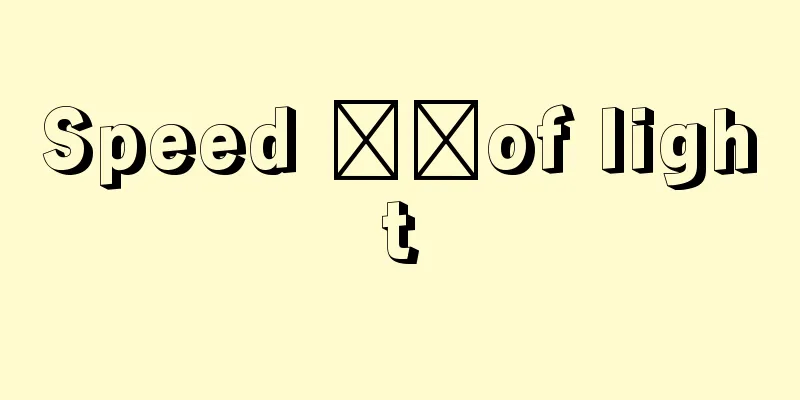Speed of light

|
The speed at which light travels. It is also simply called the speed of light. The speed of light in a vacuum is constant regardless of the frequency, and is usually represented as a universal constant c . The speed of light is about 300,000 kilometers per second, and c = 299,792.458 km/sec is currently defined as the international standard value. Light is an electromagnetic wave, and the propagation speed of electromagnetic waves and the transmission speed of electromagnetic action are both c . The principle of the constancy of the speed of light, which Einstein established along with the principle of relativity as the basis of the special theory of relativity, is the principle that the speed of light in a vacuum is always c for all observers (inertial systems) that move at a constant speed relative to each other, and is also expressed as the speed of light not depending on the motion state of the light source. The speed at which light travels through a substance is c divided by the refractive index of the medium, and is smaller than c . Light is an electromagnetic wave, and at the same time, it has particle properties as a quantum of the electromagnetic field. A quantum of light is a massless particle called a photon. The speed at which a photon travels is also c . The speed of a particle with mass cannot exceed the speed of light. For elementary particles other than photons that have zero mass, the speed of that particle is a magnitude of c . For particles with very small mass, such as neutrinos, the speed is very close to c even though the energy is small. Within the mathematical framework of the theory of special relativity, the theoretical possibility of a particle (tachyon) that is faster than the speed of light by hypothetically assuming mass as an imaginary number has been pointed out and has been pursued experimentally, but no evidence of this has been found. Historically, research into measuring the speed of light dates back to Galileo. He concluded that the speed of light was very large by measuring the time it took for light to pass between two points on the ground, but was unable to obtain a numerical value. He suggested observing the moons of Jupiter as a way to find the numerical value. In 1676, Danish astronomer Roemer was the first to find the numerical value of the speed of light by observing the changes in the eclipse cycle of Jupiter's moons. After that, many scholars, including British astronomer J. Bradley in 1727, French physicist Fizeau in 1848, J. B. L. Foucault in 1850, and American physicist Michelson in 1926, each measured it using their own method. In order to accurately determine c , it is necessary to synchronize clocks located at two separate points on the ground. To solve this difficulty, a device was devised to use a reflected light signal. The speed of light is a fundamental physical constant that appears in descriptions ranging from phenomena in the universe to the microscopic world (atoms, molecules, atomic nuclei, and the world of elementary particles). Because its value is important, the accuracy of its measurement has been constantly improved. In 1983, the unit of length was determined based on the unit of time and the speed of light, and the value of c shown above became the defined value. In other words, 1 meter is the distance that light travels in a vacuum in 1/299,792,458 of a second. [Ryozo Tamagaki and Tsuneo Uematsu] "Modern Physics Told Through Light: Pursuing the Mystery of the Speed of Light C" by Keita Koyama (Kodansha Bluebacks) [References] | | | | | |Source: Shogakukan Encyclopedia Nipponica About Encyclopedia Nipponica Information | Legend |
|
光が伝わる速さ。単に光速ともいう。真空中における光速度は、振動数に関係なく一定で、普遍定数として通常cで表す。光速は毎秒約30万キロメートル、現在c=299792.458km/secが国際的な標準値と定義されている。光は電磁波であり、電磁波の伝搬速度も、電磁的作用の伝達速度も、cである。アインシュタインが特殊相対性理論の基礎として、相対性原理とともに設定した光速度不変の原理は、互いに等速度運動をするすべての観測者(慣性系)に対して真空中の光速度はつねにcであるという原理であり、光速度は光源の運動状態によらないとも表現される。物質中を光が伝わる速さは、cを媒質の屈折率で割った値で、cより小さい。光は電磁波であるとともに、電磁場の量子として粒子性を有している。光の量子は質量ゼロの粒子であり、光子(フォトン)とよばれる。光子が伝わる速さもcである。質量をもつ粒子の速度は光速度を超えることはできない。光子以外の素粒子でも質量がゼロならば、その粒子の速度はcの大きさとなる。ニュートリノ(中性微子)のように質量が非常に小さい場合には、エネルギーは小さくても速さはcに非常に近い。特殊相対性理論の数学的枠組みのなかで、仮想的に質量を虚数にとって超光速粒子(タキオン)の理論的可能性が指摘され、実験的にも追究されたことがあったが、その証拠となるものはみいだされていない。 光速度を測る研究は、歴史的にはガリレイにまでさかのぼる。地上の2点間を通過する時間を測る方法で、光速は非常に大きいとの結論を得たが、数値は求められなかった。彼は、数値をみいだす方法として、木星の衛星の観測による方法を示唆した。1676年にデンマークの天文学者レーマーが、木星の衛星の食周期の変化を観測して、初めて光速の数値をみいだした。その後、1727年にイギリスの天文学者J・ブラッドリー、1848年にフランスの物理学者フィゾー、1850年にJ・B・L・フーコー、1926年にアメリカの物理学者マイケルソンなど多くの学者がそれぞれ独自の方法によって測定を行っている。cを正確に決定するためには、地上の2点に離れた時計をあわせる必要がある。この困難を解消するため、反射して返ってくる光の信号が用いられるようくふうされた。 光速度は宇宙における現象から微視的世界(原子・分子、原子核、素粒子の世界)に至る記述に表れる基礎物理定数である。その値は重要な意味をもつことから、測定値の精度の向上が絶えずなされてきた。1983年に長さの単位を時間の単位と光速度から定めることになり、前掲のcの値は定義値となった。すなわち、1メートルは光が真空中を2億9979万2458分の1秒の間に進む距離である。 [玉垣良三・植松恒夫] 『小山慶太著『光で語る現代物理学――光速Cの謎を追う』(講談社・ブルーバックス)』 [参照項目] | | | | | |出典 小学館 日本大百科全書(ニッポニカ)日本大百科全書(ニッポニカ)について 情報 | 凡例 |
Recommend
Knowledge Science (English spelling)
The study of knowledge is based on the metaphysics...
"Histoire des oracles" (English)
…Furthermore, in “Conversations on the Plurality ...
Jules Laforgue
A French poet from the late 19th century. Born on...
Morikazu Numa - Morikazu Numa
Journalist, civil rights activist, and politician...
Milon base - Milon Enki
Chemical formula: Hg 2 N(OH)・2H 2 O. When yellow m...
Ropshin, V. (English spelling) RopshinV
…He was arrested in 1906, but escaped with the he...
Shinzo Fukuhara
Photographer. Born in Tokyo. Entrepreneur who ser...
Onifusube - Onifusube
A mushroom of the Basidiomycete and Gastromycete ...
tertiary education
…In response, the mission of universities, namely...
Psalmi Salomonis; The Psalms of Solomon
The only psalm in the Old Testament pseudepigraphy...
Moreto (English spelling) Agustín de Moreto y Cavaña
1618‐69 Spanish playwright. Born into an Italian m...
equivalent direct radiation
…The capacity of these radiators is expressed in ...
Ogburn - William Fielding Ogburn
American sociologist. After graduating from Merce...
Robotics
A field of engineering that focuses on control eng...
Palindrome poem - Kaibunshi (English spelling) huí wén shī
Also called a round rhyme or round rhyme style. A ...









